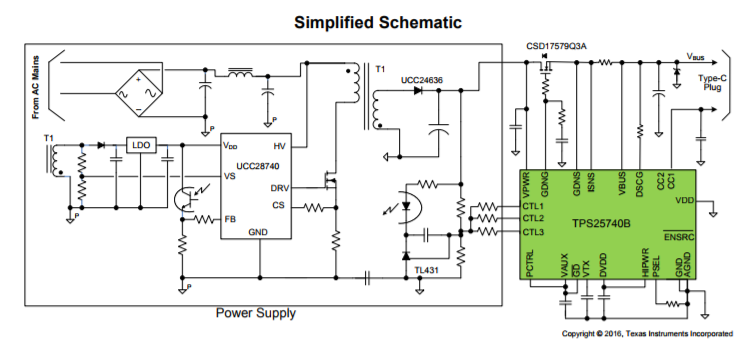SSZT760 march 2018 TPS25740 , TPS25740B , UCC28740

Many electronic system designers are interested in implementing USB Type-C™ and USB Power Delivery (PD) while getting their products to market as quickly as possible. Most USB Type-C applications require a microcontroller (MCU) because of the need for firmware configuration via the I2C, Serial Peripheral Interface (SPI) and/or Universal Asynchronous Receiver Transmitter (UART) data communication protocols.
But what if you could implement USB Type-C and USB PD without any firmware configuration or an external MCU and get your product to market fast?
Let’s say that you are designing an AC/DC power adaptor with the UCC28740 flyback controller using opto-coupled feedback and the TPS25740B USB Type-C and USB PD source controller, as shown in Figure 1.
 Figure 1 AC/DC Adapter Simplified
Schematic Using USB Type-C and USB PD
Figure 1 AC/DC Adapter Simplified
Schematic Using USB Type-C and USB PDThe TPS25740B has three control pins (CTL1, CTL2, and CTL3) which adjust the output voltage of the power supply based on the voltage requested by the attached sink. In other words, the CTL pins adjust the resistive feedback network of the optocoupler transmitting to the UCC28740 in order to output the desired voltages on the VBUS line in real time. This is what enables effortless USB Type-C PD adoption without the need for any firmware implementation.
Table 1 below shows the TPS25740B CTL pin states as a function of the target voltage on VBUS.

|
The voltages that are advertised depend on the USB PD source controller and how the device is configured. There are a variety of USB PD source controllers on the market today that can be configured to advertise a range of commonly desired voltages. One family of these devices and their voltage offerings can be seen below in Table 2.

|
In conclusion, there are a variety of USB Type-C and PD source controllers available today that can be used to reduce time to market. So, consider using a device without the need for firmware or an MCU for your USB Type-C and PD design and get your product to market fast.
Additional Resources
- Start your design with these reference designs